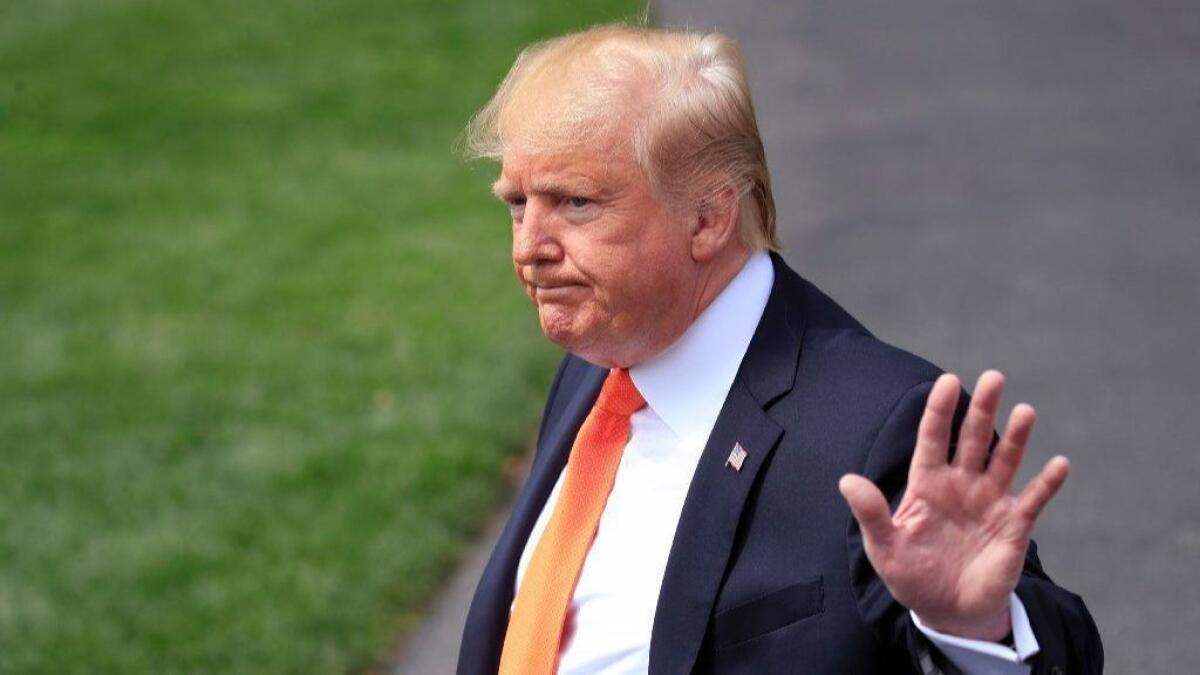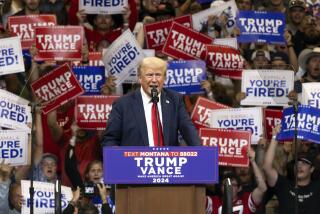In reelection pitch, Trump seeks to balance grievance and accomplishment

- Share via
Reporting from Washington — Partway through an 88-minute speech to Republicans at a black-tie fundraising dinner this month, President Trump spent six minutes wondering aloud about the theme for his reelection campaign.
“Do I go with ‘Make America Great Again?’ Or do I go with ‘Keep America Great?’” he said, twice asking the crowd to clap for the slogan they preferred. (Results were inconclusive.)
“It’s hard. It’s the greatest theme in the history of American politics,” he said, referring to his 2016 slogan. “How do you give that up for a new one?”
The still unsettled question — Trump hinted “we may try and do both” — underscores not only Trump’s fixation with branding but also the tension in his quest for four more years:
This unconventional president, who depends on grievance to animate the electorate, needs to keep his core supporters riled up by emphasizing crises, real and contrived, while convincing swing voters that he’s made their lives better and kept his promises to fix things.
“In 2016, Donald Trump won the Oval Office because he was the candidate of change,” Karl Rove, President George W. Bush’s campaign strategist, said during an interview in his Austin, Texas, office.
“Given that a majority of people today think the country is off on the wrong track, it will be difficult for him to win reelection if the message is just, ‘Look, I put us all in the right place.’ He has to both describe his next chapter of changes for the country while disqualifying his opponent as the wrong kind of change.”
Trump has time to fine-tune his pitch, with more than 14 months until Democrats nominate his opponent. And unlike four years ago, when he had to pay passersby outside Trump Tower to watch him descend an escalator and announce his campaign while insisting big donors were corrupting his opponents, he is set to run a second time with all the advantages befitting an incumbent: vast financial resources, no serious primary rivals and a larger, more professional campaign.
Operating out of a 14th-floor office building across the Potomac River from Washington in space last occupied by a hedge fund, Trump’s 2020 campaign team is building a more sophisticated operation than the president relied on four years earlier.
Shiny new flat-screen TVs hang from the walls in a war room area. Down the hall, workers are building a television studio where officials and surrogates will be able to conduct live interviews without leaving the office. Outside the windows of a massive conference room, the nation’s capital unfolds below with only one significant landmark out of view: the White House.
It is not the campaign apparatus of an underdog or outsider. But it exists to amplify the message from a president who, campaign advisors said, maintains “an insurgent mentality.”
“In 2016, his was the campaign of insurgency — he was the outside businessman who would go to Washington and disrupt things,” said Tim Murtaugh, the campaign’s communications director. “And I think everyone has to agree he has been a disruptor. The Washington establishment still doesn’t know what to make of him. And so I think he’s the same candidate today that he was in 2015.”
Marc Lotter, a former spokesman for Vice President Mike Pence who is now working as a communications advisor for the campaign, was part of Trump’s 2016 campaign, which he likened to a “guerrilla operation.”
“The difference here is there is going to be a juggernaut behind him,” he said, referring to the cash infusion from traditional Republican donors.
In some cases, what Trump’s team touts as highly sophisticated campaign science is simply standard practice in professional politics. In 2016, the president’s political operation wasn’t capturing voter information from people who attended his rallies and cross-referencing it with voter files; now it is, intent on building an army of volunteers to contact the 23 million voters the campaign believes will swing the election.
Four years ago, Trump spoke openly about his suspicions that the party apparatus, especially early in the primary season, was working against him. Once he was crowned the GOP nominee, the Republican National Committee had to scramble to provide data and a get-out-the-vote operation that Trump’s bare-bones outfit didn’t have. Now, there’s little doubt that it’s Trump’s party and there is a more seamless integration of staff in Washington and on the ground in key states.
“The difference this time is that we have a lot of professionals, a lot more resources,” Jared Kushner, Trump’s son-in-law and advisor, said during an appearance this week at the Time 100 symposium in New York.
Kushner argues that voters will focus on the big picture of economic growth and no new wars.
“As long as the president is able to keep delivering on his promises of keeping the economy strong and keeping us safe, I think there’s a lot of people in this country who are very appreciative of the sacrifices he’s making to do the job he does and are very pleased,” Kushner said.
But Trump is unlikely to motivate his supporters, some of whom are lower-propensity voters, solely with a positive message.
The challenge for Trump will be striking a balance among touting his accomplishments, dismissing Democrats as socialists and maintaining the banner of change. That challenge is compounded by the record, which includes policies unpopular beyond his core supporters such as building a border wall and separating asylum-seeking parents from their children.
“It’s usually a mix that makes the difference, and that is whether a president has delivered on some of his promises and is seen among his supporters as fighting for the rest,” said David Gergen, who has advised four U.S. presidents dating to the Nixon administration.
“There is a sense among his base that he has tried hard to deliver on what he said, and they have a friend in the White House, which counts for a lot,” he said. “But that comes at great expense to his relationship with independents,” who in many cases see those same fights as Trump acting in excess.
Trump is rare among American presidents in having eschewed a broader, more unifying approach to the office, said Tim Naftali, a presidential historian at New York University.
“He has remained as sectarian as he was in his inaugural address, which was a jeremiad for his base, not a message that he’s president of the entire country,” Naftali said.
“He’s going to have to engage in some verbal gymnastics to be reelected on a message promising to make the country as great as it was before he was elected president,” Naftali continued. But, he said, “if you inhabit his special reality, you do not see the dissonance or inconsistencies.”
Democrats, currently staring at a field of 20 presidential contenders, could focus on the president’s conflicting message and divisive rhetoric, but some party strategists believe they’ll be more successful reminding swing voters that the president hasn’t materially helped the blue-collar workers across the Midwest who helped elect him four years ago.
“It’s a huge challenge for Trump in that he ran as a populist and governed as a corporatist,” said Dan Pfeiffer, a former Obama strategist who now hosts a popular political podcast.
Democrats, he said, will need to “pierce that image of him as a working-class champion” and someone who has kept his promises by pointing to the “massive corporate tax cut paid for by jacking health premiums and trying to cut Medicare.”
“There is an ample body of evidence to make a case against Trump,” he said. “We just have to do it.”
More stories from Eli Stokols »
More to Read
Get the L.A. Times Politics newsletter
Deeply reported insights into legislation, politics and policy from Sacramento, Washington and beyond. In your inbox twice per week.
You may occasionally receive promotional content from the Los Angeles Times.












